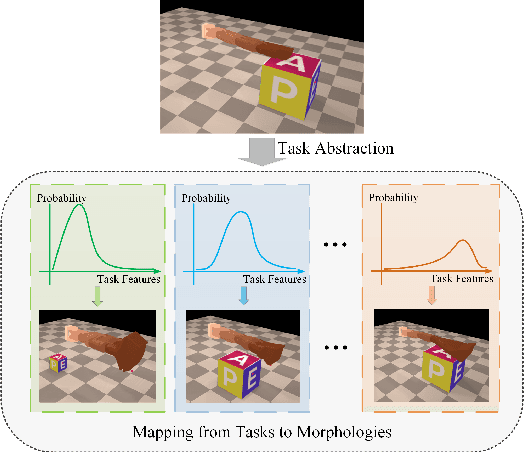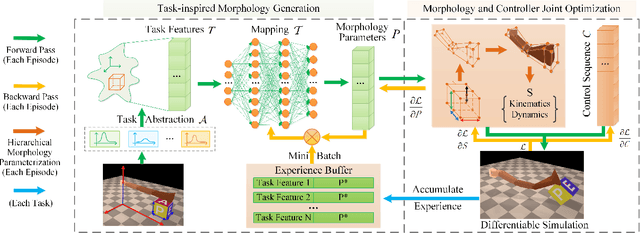Yunxin Mao
MRBTP: Efficient Multi-Robot Behavior Tree Planning and Collaboration
Feb 25, 2025Abstract:Multi-robot task planning and collaboration are critical challenges in robotics. While Behavior Trees (BTs) have been established as a popular control architecture and are plannable for a single robot, the development of effective multi-robot BT planning algorithms remains challenging due to the complexity of coordinating diverse action spaces. We propose the Multi-Robot Behavior Tree Planning (MRBTP) algorithm, with theoretical guarantees of both soundness and completeness. MRBTP features cross-tree expansion to coordinate heterogeneous actions across different BTs to achieve the team's goal. For homogeneous actions, we retain backup structures among BTs to ensure robustness and prevent redundant execution through intention sharing. While MRBTP is capable of generating BTs for both homogeneous and heterogeneous robot teams, its efficiency can be further improved. We then propose an optional plugin for MRBTP when Large Language Models (LLMs) are available to reason goal-related actions for each robot. These relevant actions can be pre-planned to form long-horizon subtrees, significantly enhancing the planning speed and collaboration efficiency of MRBTP. We evaluate our algorithm in warehouse management and everyday service scenarios. Results demonstrate MRBTP's robustness and execution efficiency under varying settings, as well as the ability of the pre-trained LLM to generate effective task-specific subtrees for MRBTP.
Efficient Behavior Tree Planning with Commonsense Pruning and Heuristic
Jun 04, 2024



Abstract:Behavior Tree (BT) planning is crucial for autonomous robot behavior control, yet its application in complex scenarios is hampered by long planning times. Pruning and heuristics are common techniques to accelerate planning, but it is difficult to design general pruning strategies and heuristic functions for BT planning problems. This paper proposes improving BT planning efficiency for everyday service robots leveraging commonsense reasoning provided by Large Language Models (LLMs), leading to model-free pre-planning action space pruning and heuristic generation. This approach takes advantage of the modularity and interpretability of BT nodes, represented by predicate logic, to enable LLMs to predict the task-relevant action predicates and objects, and even the optimal path, without an explicit action model. We propose the Heuristic Optimal Behavior Tree Expansion Algorithm (HOBTEA) with two heuristic variants and provide a formal comparison and discussion of their efficiency and optimality. We introduce a learnable and transferable commonsense library to enhance the LLM's reasoning performance without fine-tuning. The action space expansion based on the commonsense library can further increase the success rate of planning. Experiments show the theoretical bounds of commonsense pruning and heuristic, and demonstrate the actual performance of LLM learning and reasoning with the commonsense library. Results in four datasets showcase the practical effectiveness of our approach in everyday service robot applications.
Integrating Intent Understanding and Optimal Behavior Planning for Behavior Tree Generation from Human Instructions
May 13, 2024



Abstract:Robots executing tasks following human instructions in domestic or industrial environments essentially require both adaptability and reliability. Behavior Tree (BT) emerges as an appropriate control architecture for these scenarios due to its modularity and reactivity. Existing BT generation methods, however, either do not involve interpreting natural language or cannot theoretically guarantee the BTs' success. This paper proposes a two-stage framework for BT generation, which first employs large language models (LLMs) to interpret goals from high-level instructions, then constructs an efficient goal-specific BT through the Optimal Behavior Tree Expansion Algorithm (OBTEA). We represent goals as well-formed formulas in first-order logic, effectively bridging intent understanding and optimal behavior planning. Experiments in the service robot validate the proficiency of LLMs in producing grammatically correct and accurately interpreted goals, demonstrate OBTEA's superiority over the baseline BT Expansion algorithm in various metrics, and finally confirm the practical deployability of our framework. The project website is https://dids-ei.github.io/Project/LLM-OBTEA/.
Task2Morph: Differentiable Task-inspired Framework for Contact-Aware Robot Design
Mar 28, 2024



Abstract:Optimizing the morphologies and the controllers that adapt to various tasks is a critical issue in the field of robot design, aka. embodied intelligence. Previous works typically model it as a joint optimization problem and use search-based methods to find the optimal solution in the morphology space. However, they ignore the implicit knowledge of task-to-morphology mapping which can directly inspire robot design. For example, flipping heavier boxes tends to require more muscular robot arms. This paper proposes a novel and general differentiable task-inspired framework for contact-aware robot design called Task2Morph. We abstract task features highly related to task performance and use them to build a task-to-morphology mapping. Further, we embed the mapping into a differentiable robot design process, where the gradient information is leveraged for both the mapping learning and the whole optimization. The experiments are conducted on three scenarios, and the results validate that Task2Morph outperforms DiffHand, which lacks a task-inspired morphology module, in terms of efficiency and effectiveness.
* 9 pages, 10 figures, published to IROS
 Add to Chrome
Add to Chrome Add to Firefox
Add to Firefox Add to Edge
Add to Edge